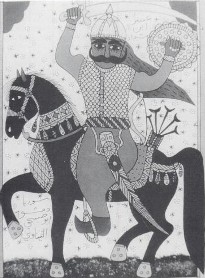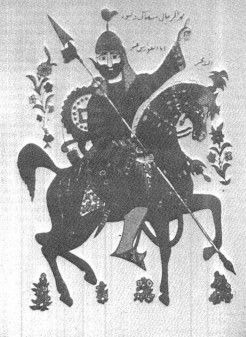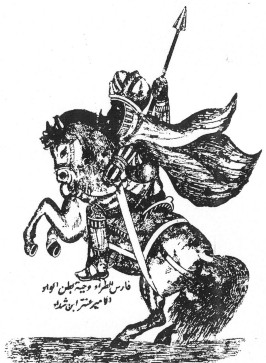To next page
Asmaee: Antar, (a Bedoueen Romance) (around 800) from Arabia
--------------------------------------------

Oral tradition written down by Asmaee during the reign of Haroon Rasheed (2nt century AH). The Hero of the Romance is Antar the son of an Arab prince and an African slave mother.
Contents: The romance brings us through numerous legendary stories from early times down to the period when King Zubair is ruling over the Banu Abs. The Abai hero Shaddad on a raid captures the negro-slave-girl Zabiba (not till the 18th book do we get the denouncement that she is the king�s daughter, who had been carried off from the Sudan), who becomes the mother of Antar. As an infant Antar tears the strongest swaddling clothes, at two years old pulls down the tent, at four slays a large dog, at nine a wolf and as a young shepherd a lion. Soon he comes to the rescue of his oppressed tribe, for which he is acknowledged by his father and adopted into the tribe. He seeks Abla, his uncle�s daughter, in marriage; the latter promises her to him in an hour of need; but after Antar has averted the danger, he imposes the most dangerous conditions to be carried out before the marriage. Antar fulfils them all but is only allowed to marry Abla after 10 volumes of wonderful exploits. The area of his exploits widens continually. In his own tribe Antar has first to overcome the resistance of his father, then the hostility of Abla�s relatives, to win over his rivals including the poet ���.
One of Antar�s opponents is the descendant of a jinn princess, who rides on a giraffe. He is brought out by an attack on his herdsmen and then killed.
Note; it seems that although the giraffe was known to exist not much other knowledge had reached Arabia.


This King Humam (or Hammam) was a man of great courage' He was intractable and was resolute in battle. He used to raid tribes and to capture women. He used to attack the horseman and the foot soldier (equally). He had a city which was built of white stone. There was no other city like it in that land. By report it was attributed to builders of the jinn who had raised it for our Lord Solomon, King David's son, peace be upon him. Near to that city was a hill which [rose up] like a pyramid. It was covered with vegetation and impressively sown with every kind of tree and bush. In the middle of that hill stood an upright 'sword' over which the bird constantly hovered. None could pass that 'sword' save him who was clad in white raiment. If one, whose clothes were dyed, approached it, then winds from all countries would blow fiercely upon it and a flood would descend so that the villages which were round about were almost destroyed, such was the violence of the rain. King Humam was the Lord of the Land of Monoliths In that (high) place he had left a guard to whom he paid a stipend (like that of ) the jamakiyyah and the diwan. At its [the mountain's] base was a house. When one of the people died they brought him into that house. They took the deceased, extracted his bones, stripped off his flesh and pickled it. All the marrow in his bones would be removed and they would place the bones in bags according to the rank of the deceased. As for those whom they revered, their coverings were of Byzantine brocade, while the poor were deposited in bags made of cotton and sacking. On each of these they wrote the name of the occupant. Into that house they cast him. As for the flesh, they threw it outside the city to the black crows which devoured it. They allowed no other creature to consume that flesh. They chased it away with arrows, slings and catapults. All in that city were engaged in the manufacture of armor: mail hauberks, helmets, swords, spears and everything which was concerned with weapons of war and with armaments. None [amongst them] paid tribute or tax to King Humam, and none of the other kings could take anything from them in that town and country.
Notes; there is indeed no other city like the great Zimbabwe in that land and there is an old tradition (first written down in 1609) that it was the site of King Salomon�s mines.
The pyramid hill should be the Hill Complex of Great Zimbabwe. It was the residence of King Mwene Mutapa (translated by Garlake as Master Pillager) and his guard.
There are monoliths (3 feet) found in the Hill complex with a perched bird carved on top. Garlake thinks they might have served as reminders of the individual dead.
Garlake writes that the king as a religious figure dresses simply in cotton cloth.
The Elliptical Building or Mumbahuru is �the house of the great women�. In the story of Antar (after the description here given) it is the place where the wifes and daughter of king Human are.
H.T.Norris concludes that this text can not have been existed before 1400AD and is so a later addition to the original Antar.
Taken from: Les Aventures d'Antar, fils de Cheddad, roman arabe des temps ant�-islamiques, traduit par L. Marcel Devic.
About the Ethiopian Negus and his chief warrior Abd Zinjir
Al-Asmai mentioned that there was not in the whole Sudan, neither Zanj nor Takrur, nor Ethiopia, nor of the Arab tribes one who was more skilled as a horseman than al-Abd Zinjir nor more horrible than him in aspect, nor with a louder voice when he screamed. When he cried aloud men imagined that the thunder roared. When the pregnant women heard him she miscarried and her heart burst��
He had heard that the Negus had a daughter called Manar who was more beautiful�� They advised him to marry her to al-Abd Zinjir��.
(When the armies of the Negus and Antar meet)
Al-Abd Zinjir had hardly finished his boasting when one of the negroes came before him. He was called Salhab ibn Mahbub and he was deemed to equal one thousand knights. He aimed his spear at al-Abd Zinjir. The latter waited patiently until he drew close, then he removed his foot from his stirrup and kicked his side, breaking four of his ribs. He was thrown more then 14 cubits on the ground. Then al-Abd Zinjir laughed and smiled full of contempt. Once more he sought combat.
(Finally Antar will kill al Abd Zinjir)